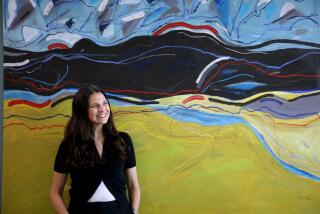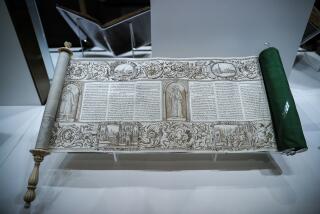Striving to preserve the rich heritage of Yiddish
In the misery of a Jewish ghetto in German-occupied Poland, Jack Lewin remembers, the books helped him survive. Reading the Yiddish words late into the night, Lewin could forget the hunger that sometimes brought him to tears.
“I lived with the characters of the books,” he says in his home near Wilshire Boulevard, his green-and-gray eyes distant with memory.
Maybe it was those books that made it possible for him and the others to be human after Auschwitz. Now he traces his fingers over the faded spines of his collection and worries aloud: Will anyone read them a century from now?
Lewin and his wife, Regina, are among a declining number of people who speak Yiddish at home in the Los Angeles area. Their small ranks dwindled by more than a thousand people between roughly 2005 and 2011 — plunging by nearly a third, estimates from the U.S. Census Bureau show.
In sheer numbers, the loss is one of the biggest among metropolitan areas nationwide. Many Yiddish secular schools were shuttered as the decades passed. The Los Angeles Yiddish Culture Club, once a thriving hub for Yiddish lectures and events, weakened as its members aged — and ultimately folded into another group with programs mostly in English.
“In just my lifetime, I went from seeing Yiddish everywhere, to having to scramble to find people to converse with,” said Miriam Koral, founding director of the California Institute for Yiddish Culture and Language. “They truly are the last of the Mohicans.”
Millions of Yiddish speakers perished in the Holocaust; others dropped the tongue to assimilate. Between 1980 and 2010, the number of Americans speaking Yiddish at home was cut in half, census data show.
Such changes have troubled scholars and activists who see Yiddish as a gateway into the world of their ancestors, the key to understanding centuries of Jewish culture rooted in Eastern Europe.
Yiddish evolved by mingling Germanic dialects with Hebrew, Aramaic and Slavic languages, among others. Not even the best translations capture the unique “juiciness” and layers of the language, Koral said.
“It’s perfectly clear to anyone who doesn’t want to delude themselves that Yiddish language is in a steep decline,” said Marvin Zuckerman, a teacher and translator who wrote a widely used Yiddish primer. “If there are no children speaking it in the streets when they play, a language is doomed.”
Yiddish is still heard on some playgrounds elsewhere in the United States: Around New York City and in Poughkeepsie in the Hudson River Valley, Yiddish has rebounded in recent years, as clusters of ultrareligious Jews use the language with their children. The faith-based language research group SIL International categorizes Yiddish as being in “vigorous use” in Israel.
But Los Angeles doesn’t have the same numbers of ultrareligious Jews as New York, said Rob Adler Peckerar, executive director of the cultural center Yiddishkayt. Even if it did, many fans of the vast trove of Yiddish literature — much of it far from religious — fear the extremely devout will have little interest in reading the Yiddish tales they treasure.
Others hold out hope that Yiddish will endure, not only in ultrareligious pockets, but as new students pick up Yiddish as a second or third language through classes and lessons. Enrollment in Yiddish language classes at colleges nationwide has fluctuated over the decades, the last available data from the Modern Language Assn. show. However, those lukewarm numbers do not include classes that are not for credit, or Los Angeles groups that bring together Yiddish speakers and would-be-speakers to practice.
“For a long time, people had dismissed Yiddish and seen it as schmaltzy or cute or nostalgic,” said Aaron Lansky, founder and president of the Yiddish Book Center in Amherst, Mass. Today, he said, “people are connecting with it in a serious way.”
In a bare room at a West Hollywood community center, roughly a dozen people gathered one Sunday to chat and sing in Yiddish, their voices warbling over lyrics on photocopied sheets. Many had heard the language at home as children, but never learned to read or write it, or became shaky at speaking it as years passed, said Rashel Lipovetsky, a former teacher involved with the Plummer Park Yiddishists group for advanced speakers. Others sought out Yiddish for themselves.
In Israel, where Amnon Friedman grew up, “it was a language of shame. A dead language,” he said outside the community center. After his mother passed away, he felt suddenly cut off from the past, and decided to learn Yiddish. Reading the stories of Sholem Aleichem and other famous authors, “I felt like I was standing in my grandfather’s house.”
Even as fewer Angelenos gab in Yiddish at home, a “metalinguistic community” has popped up here — people who feel emotionally tied to Yiddish even though they may not speak or read it well, linguist Netta Avineri wrote in her UCLA dissertation last year.
Several Los Angeles groups focus on fostering Yiddish culture: Sholem, a local secular institution, aims to help children “get the taste of Yiddish in their mouths,” since there is too little time in class to master it, its education director Hershl Hartman said. A Meetup.com group, the Yiddish Culture Collective, has screened Yiddish films subtitled in English and hosted “vocal jamming” next to Canter’s Deli, near the Fairfax district, along with Yiddish conversation groups like the one in Plummer Park.
But some remain skeptical that such affection does much for the language. “I’m not against any of that, but we mustn’t fool ourselves that it’s a replacement,” said Dovid Katz, a Yiddish scholar based in Lithuania. “You can’t study Yiddish without Yiddish any more than you can study Spanish without Spanish or French without French.”
After Lewin was freed from Auschwitz, and met and wed Regina in Belgium, they went as far away from Europe as they could. Australia was the easiest to get into, he said, and it was “the end of the world” — which seemed like a good thing after so much war.
Even at the end of the world, Yiddish came with them. For 15 years Lewin acted in the Yiddish theatre in Melbourne, working by day and rehearsing by night. He remembers it as one of the most beautiful times in his life, the curtain going up on weekends to adoring crowds.
As they moved on to Los Angeles, his 5-year-old daughter wandered the aircraft, regaling passengers with Yiddish songs. Lewin has grandchildren now, and great-grandchildren. But he doubts they will speak Yiddish.
As for the books lining his shelves? He plans to send them to the Yiddish Book Center, but wonders whether they will be read as he read them.
Perhaps “some academics will study it chapter by chapter for months,” Lewin said. “But I don’t think this is what it was meant to be.”
More to Read
Start your day right
Sign up for Essential California for news, features and recommendations from the L.A. Times and beyond in your inbox six days a week.
You may occasionally receive promotional content from the Los Angeles Times.






